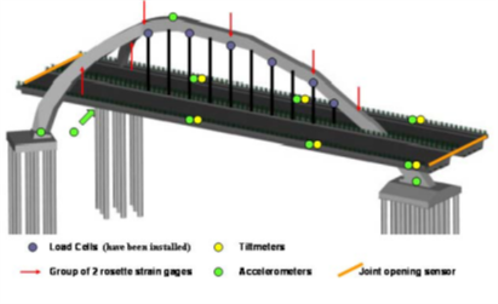
The Monitoring Department of Rasis Afzar Co., Ltd., with the help of its experienced engineering team and based on the R&D studies and investigations, has defined, designed and carried out many different projects for different applications as required by its Clients.
Following are the instances of the projects for which our Monitoring Department has offered or carried out for its Clients:
Milad Tower
Milad tower with the height of 435 meter is the fourth highest telecommunication tower in the world and considered the highest in the Middle East. In order to provide safe and multipurpose services it has been fully equipped with fiber optic structural health monitoring system.
A complete range of 79 single axis accelerometers, 32 long gaged fiber optic strain/deformation sensors, 4 fiber optic inclinometers and 3 anemometers with the highest possible resolution and accuracy recording every movement of the tower; and the information is processed online by the world's number one vibration analyzes and monitoring softwares.
The monitoring system has been installed with the following characteristics:
The system is mainly consist on fiber optic based sensor, having as main characteristic the insensitivity to electromagnetic fields. This characteristic will also guarantee long-term reliability and immunity from other external influences (e.g. cross talk). Conventional sensors are exceptionally used when no fiber optic sensors are available for a specific measurement type (e.g. anemometers).
The system is able to combine, store and manage data from sensors measured automatically, from manual measurements and other observations.


The data acquired by sensors are managed centrally with a unified user interface and will be stored in a consistent file system structure and partially in a relational database structure. Warnings can be issued based on pre-defined conditions.
All the sensors are connected to the Central Measurement Point using either optical fibers. All sensors (strain, temperature, accelerometers and inclinometers) are read simultaneously with a typical (customizable) acquisition rate of 0.1 Hz (static measurements during normal operation of the system). Based on customizable pre-defined triggers, the system is able to automatically switch to dynamic measurements with maximal acquisition rate of 125 Hz.
System is able to monitor the structure behavior during the earthquakes, storms or any unpredictable events dynamical and continuously. Many case studies have been done in this department since the establishment and execution of a few masterpiece projects are great proves to the above claim.
 Moreover, we have had cooperations with the following organizations giving them Structural Health Monitoring engineering services:
Moreover, we have had cooperations with the following organizations giving them Structural Health Monitoring engineering services:
- Road Ministry of Iran
- Rail and Truck Organization of Iran
- National Iranian Oil Companies (NIOC)
- National Iranian Gas Companies (NIGC)
- Iranian Petrochemical Companies (IPC)
- Yademan Saze engineering company (Milad Tehran Telecom. Tower) (Associated with Tehran Municipality)
- Tehran Municipality Civil Engineering Department
- Tehran Subway Company
Tangeh Nali Gas Pipeline Landslide Monitoring
Located at the Kilometer 96 of the first national Iranian Gas pipeline there is a very huge stone rock pressuring nearby soil by its weight causing continual landslides in the southern areas where the 48 inch gas pipeline is buried.
Rasis Afzar Monitoring Department has installed a proper set of fiber optic strain monitoring sensors on the body of the pipeline in this potentially dangerous area to monitor soil pressure and preventing such a catastrophic accident that happened in the past at this area.


Ghotour Bridge
Ghotour Bridge is a railway bridge in Khoy County, West Azerbaijan Province, Iran over the Ghotour River. It is an arch bridge, was completed in 1970, and has a length of 442.9 meters with the largest span being 223.1 meters.


Veresk Bridge
The Veresk Bridge was constructed in Iran mostly by Austrians before World War II. It is located in the Veresk, in Mazandaran Province. The Bridge stands at 110 meters tall and its arch measures 66 meters long. The bridge serves the Trans-Iranian Railway network in Northern Iran.


Javadiyeh Bridge
Javadiyeh Bridge, 126m long and 30m wide, is located in the south of Tehran. The bridge’s unusual geometry and asymmetrical main arch required the project engineers to use asymmetrical piers with a single, high tension cable to suspend the bridge from its middle section. The bridge also uses eight shock transmitters below the deck to transfer vibrations from the 900 tone deck to the lateral columns.

